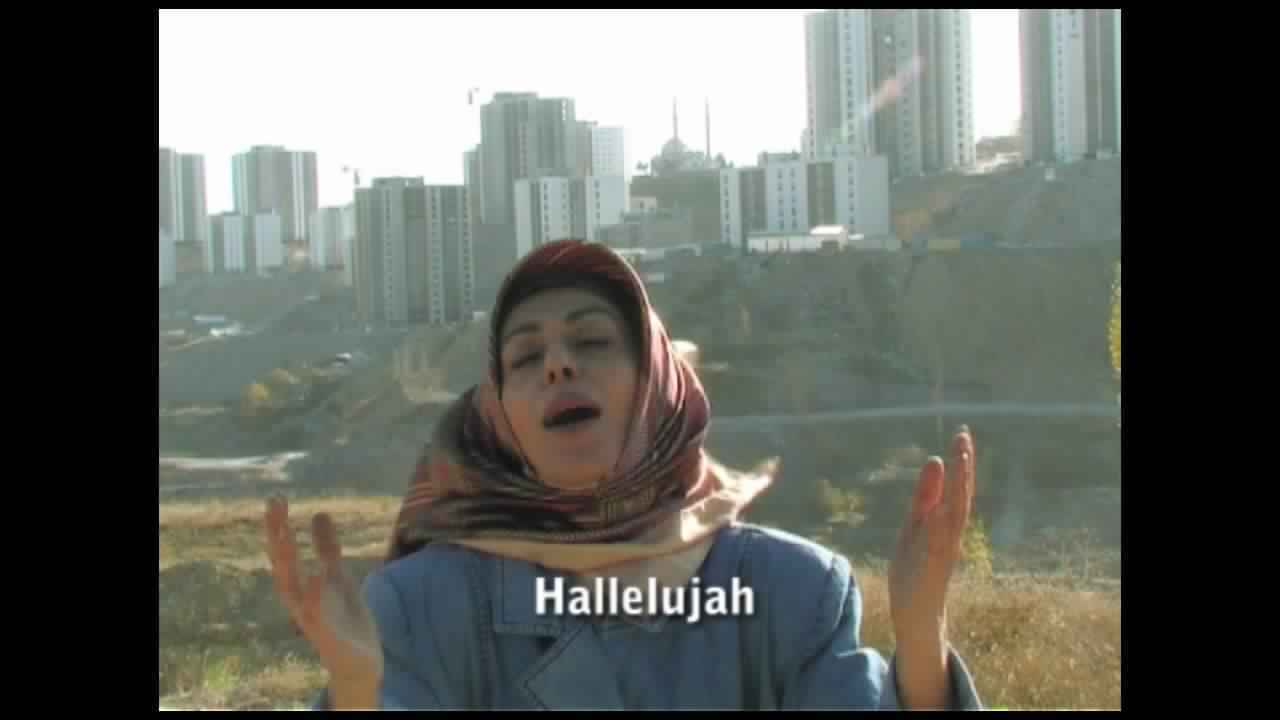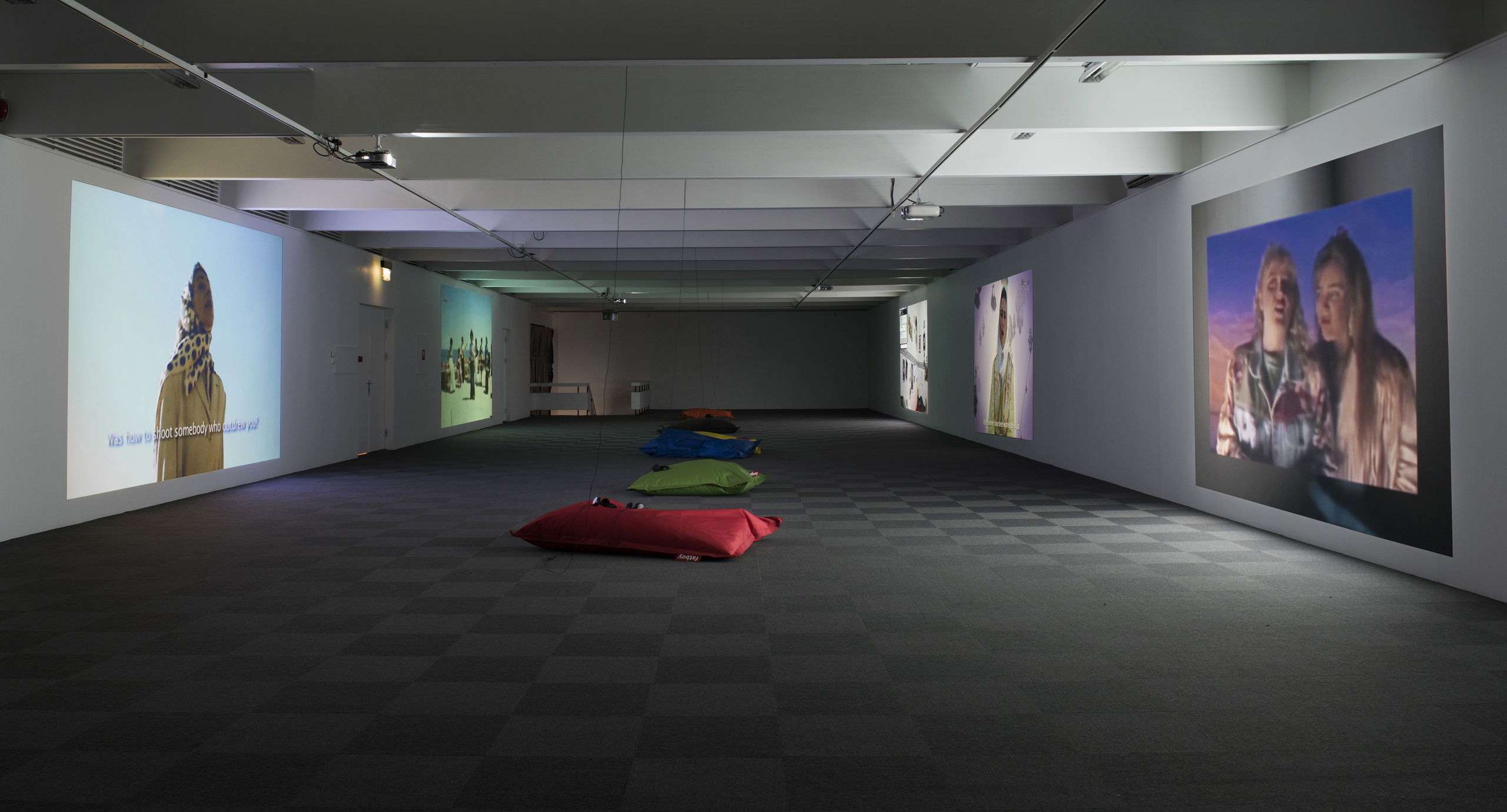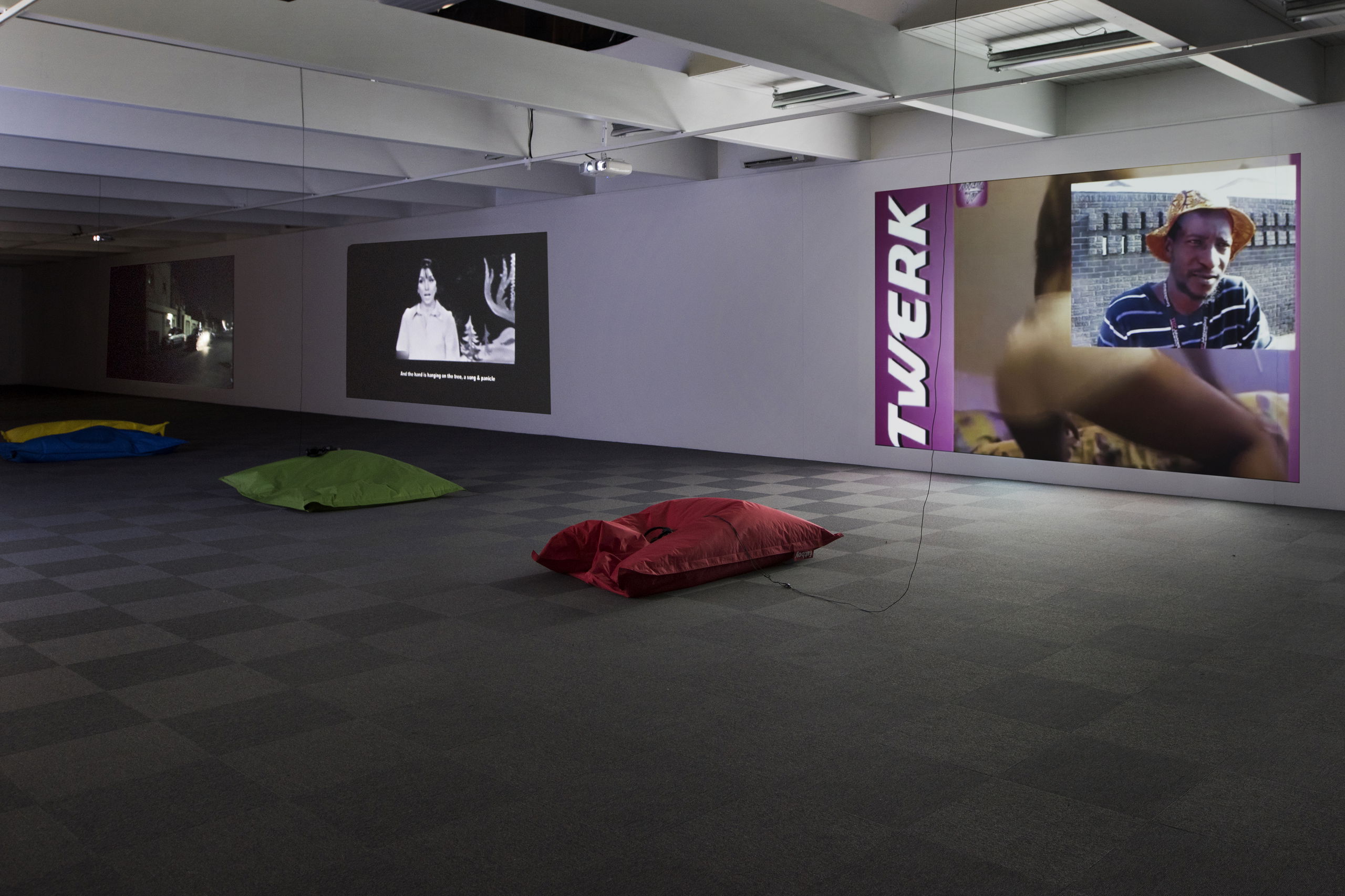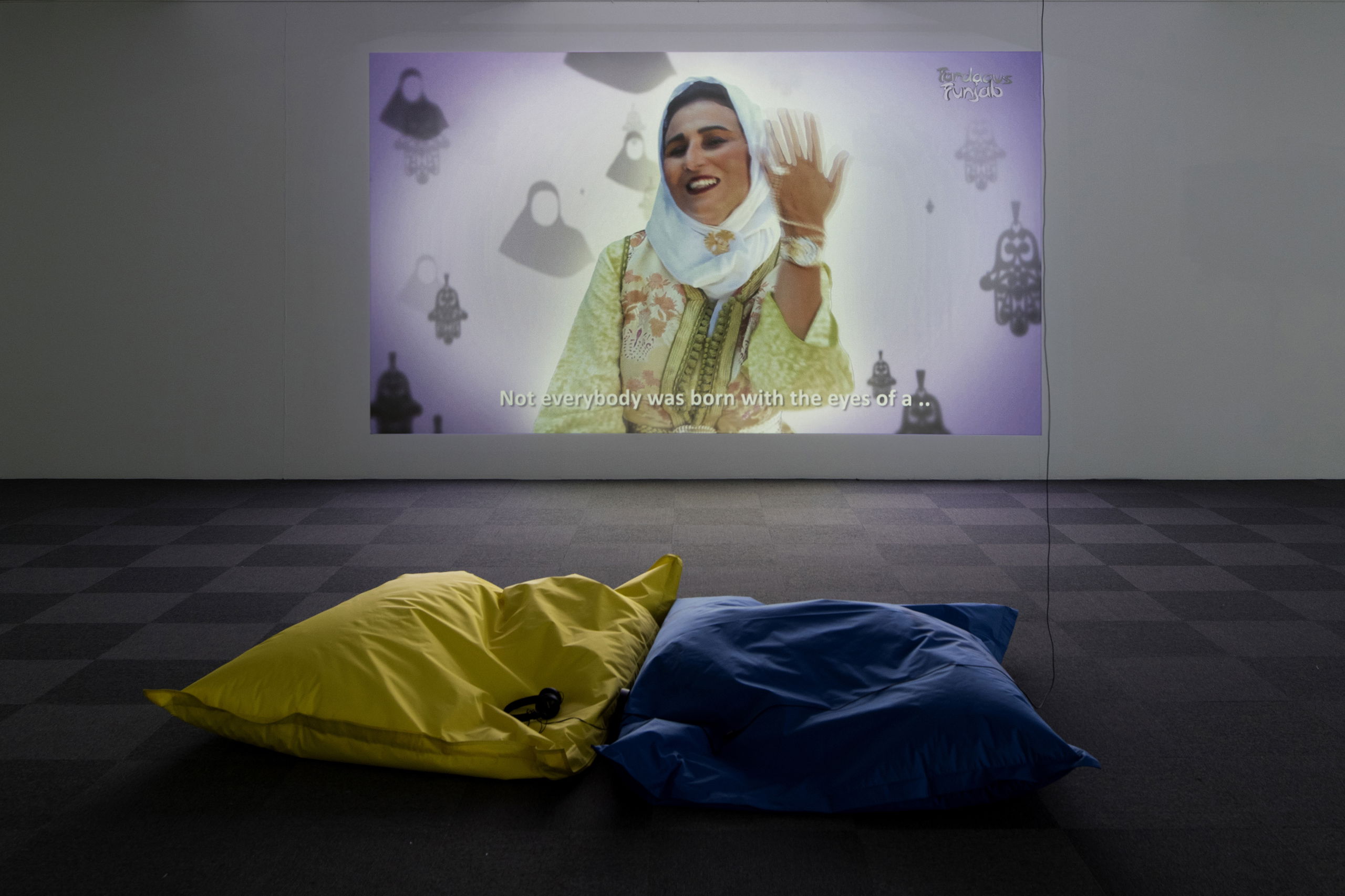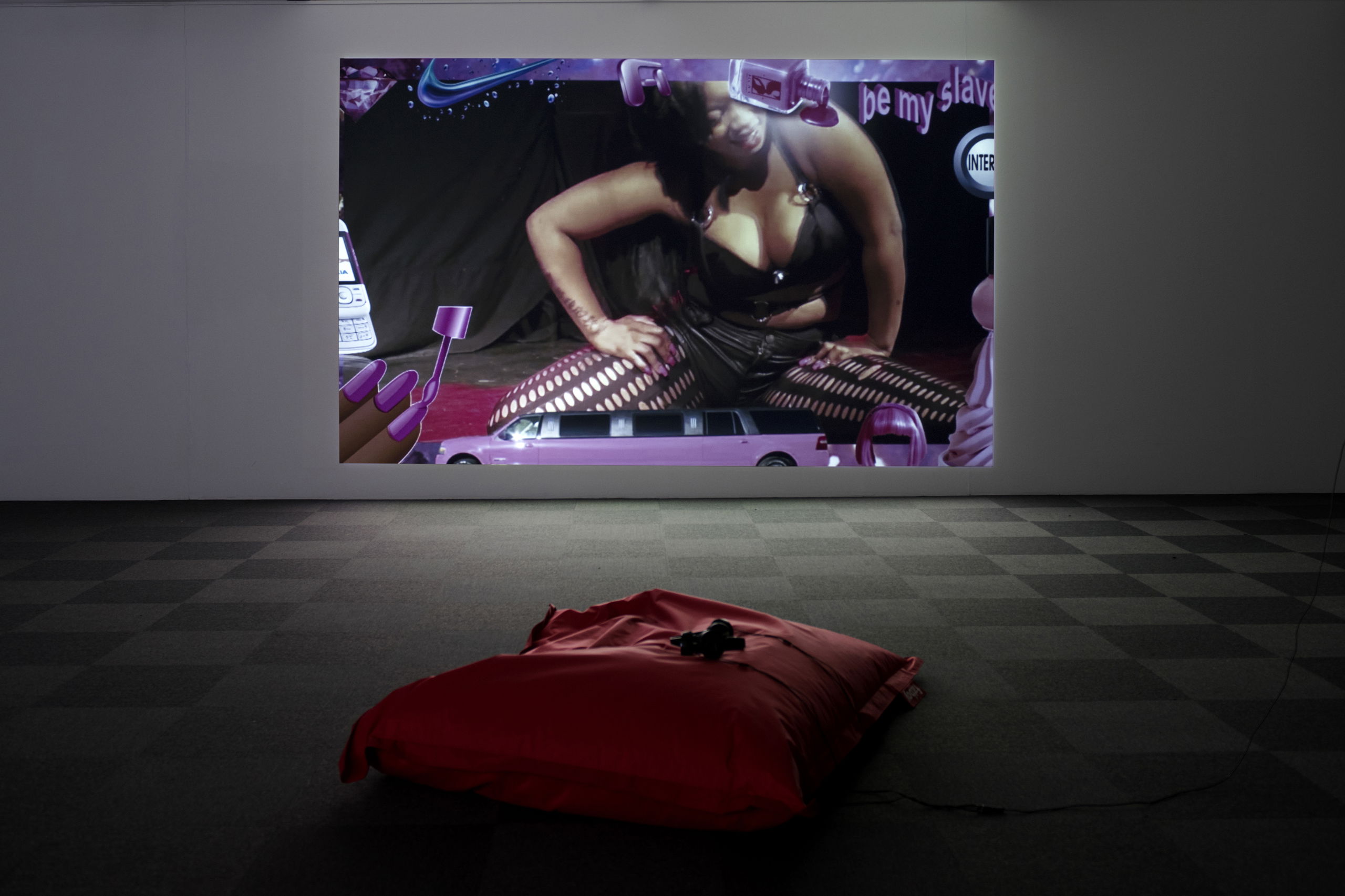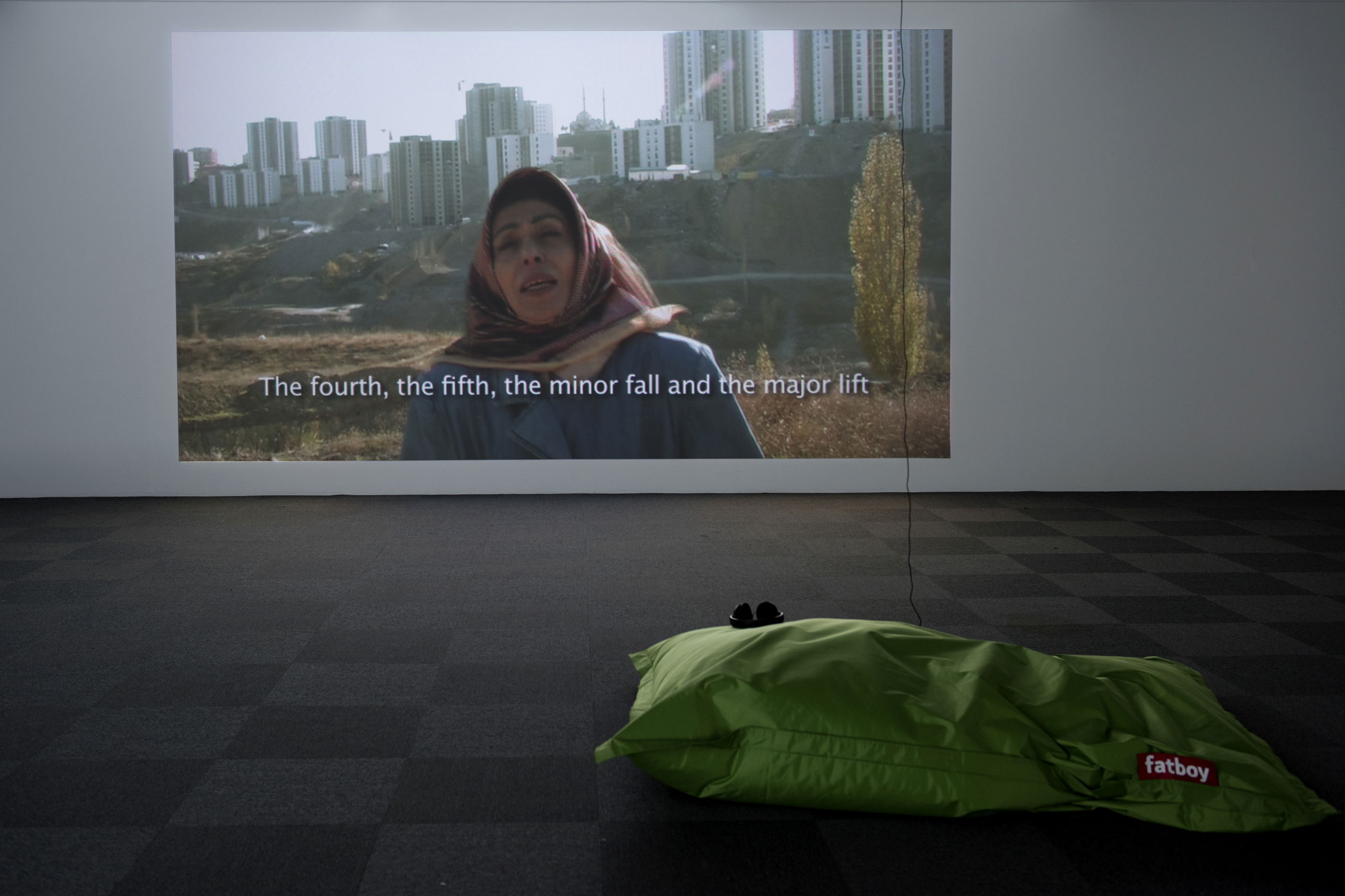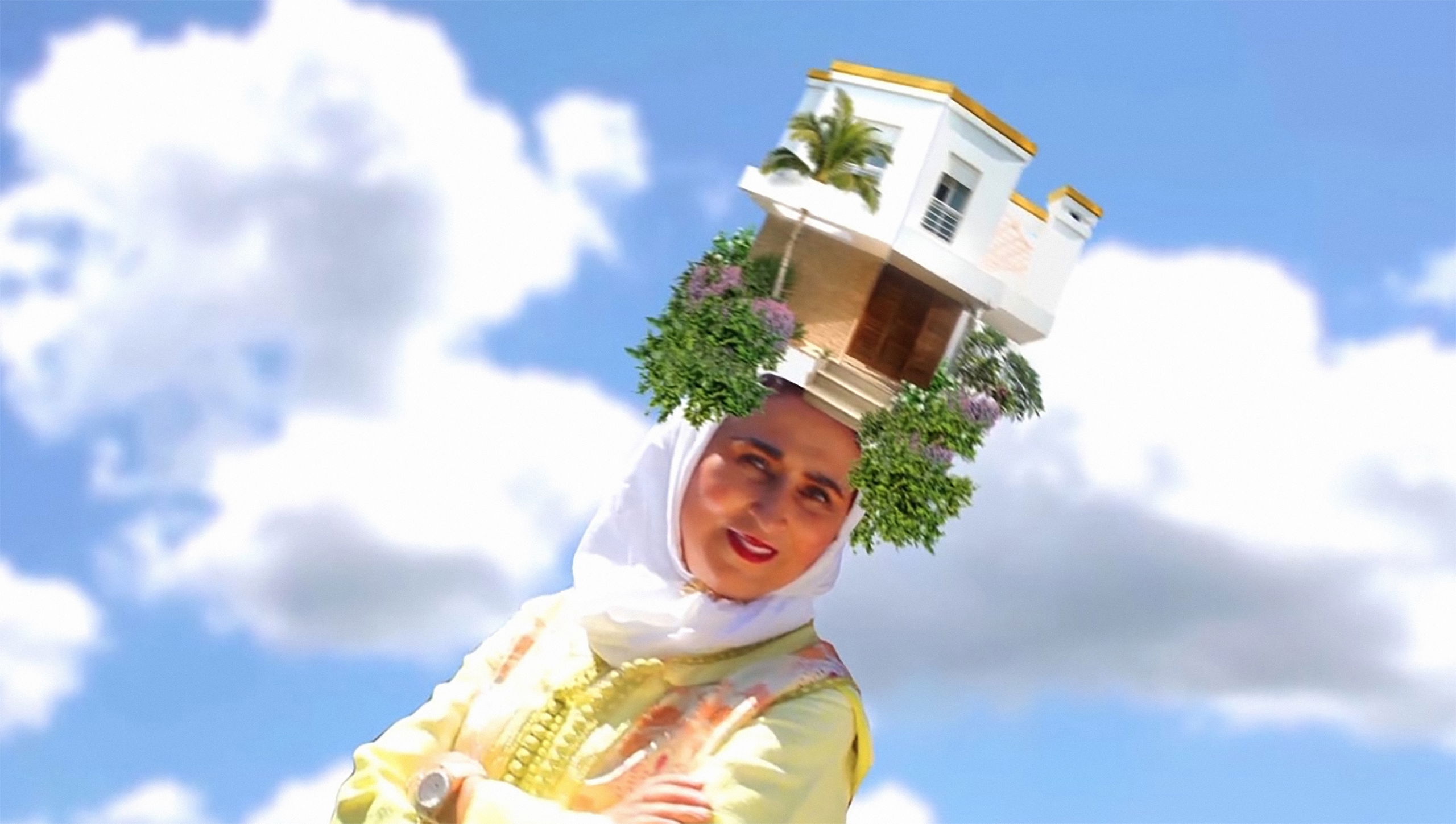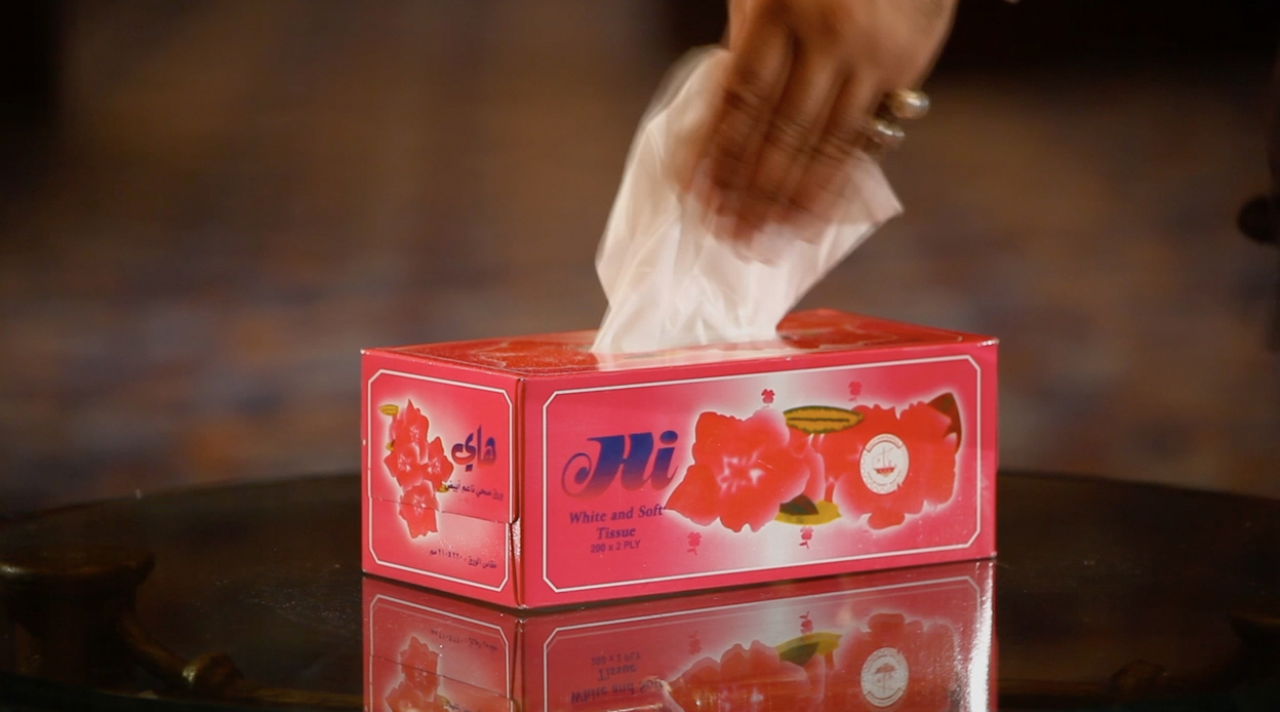
Kunsthall Stavanger is proud to present I Heard You Laughing, an exhibition of video work from the Middle East in its broad acceptation, curated by Myriam Ben Salah and Martha Kirszenbaum.
Artists from the Middle East are often associated with narratives of struggle and rhetoric of the past. Some end up making works that are almost a response to a Western “tacit commission”—as coined by Moroccan scholar Mohamed Rachdi—arbitrarily linking authenticity with traumatic storytelling. I Heard You Laughing borrows its title from 14th century Persian poet Hafez’s book I Heard God Laughing, in which he lauded the joys of love, humor and irony, three clogged pillars of Middle-Eastern culture that are making a controversial comeback in the works of a younger generation of artists from the region.
I Heard You Laughing reflects on the importance of popular culture, the omnipresence of technologies and the role of music and dance, while
Kunsthall Stavanger is proud to present I Heard You Laughing, an exhibition of video work from the Middle East in its broad acceptation, curated by Myriam Ben Salah and Martha Kirszenbaum.
Artists from the Middle East are often associated with narratives of struggle and rhetoric of the past. Some end up making works that are almost a response to a Western “tacit commission”—as coined by Moroccan scholar Mohamed Rachdi—arbitrarily linking authenticity with traumatic storytelling. I Heard You Laughing borrows its title from 14th century Persian poet Hafez’s book I Heard God Laughing, in which he lauded the joys of love, humor and irony, three clogged pillars of Middle-Eastern culture that are making a controversial comeback in the works of a younger generation of artists from the region.
I Heard You Laughing reflects on the importance of popular culture, the omnipresence of technologies and the role of music and dance, while tackling a form of vernacular disorientalism and conveying a certain digital cosmopolitanism. It comprises selected music videos from iconic Middle-Eastern musicians of the 1950s-60s-70s alongside video works by contemporary artists that reflect the complexities of this often oversimplified ‘East-West’ configuration.
Participating artists include: Sarah Abu Abdallah, Sophia Al-Maria, Fatima Al Qadiri and Khalid Al Gharaballi, Meriem Benanni, Bendaly Family, Fairuz, Googoosh, Ferhat Özgür and Dor Zlekha Levy.
Laylit Eid Fairuz, Jingle Bells (c.1965) 02:51 min
Beirut, Christmas of 1965. Iconic Lebanese performer Fairuz appears on national television interpreting a version of the Christmas carol ‘Jingle Bells’. She is singing straight to the camera, in Arabic, and the song is now entitled ‘Laylet Eid’. The broadcast of this moving version of a traditional Christian song might have brought together, inside their own living rooms and in front of their black and white televisions, thousands of viewers from the Arab World, and expressed how intricately linked Muslim and Christian cultures appear to be, and how deeply they have coexisted for the past centuries.
Meriem Bennani, Fardaous Funjab (2015-17) S1 EP1 09:31 min
With wry humor and a subtle ability to misappropriate
the clichés of North African culture, New York-based artist Meriem Bennani interlaces references to the globalized pop
and the vernacular representation of her native Morocco. Fardaous Funjab (a contraction of ‘fun’ and ‘hijab’) was inspired by the infamous American TV show Keeping Up with the Kardashians and is constructed as a multi-episode reality show that introduces Fardaous, a fictional successful hijab designer, whose delirious and absurdist creations transform a sometimes-controversial religious attribute into a fashion pop accessory. Bennani shot the first two episodes at her parent’s house in Rabat, casting her mother and aunts. Rather than a comment on the Muslim veil itself, what Bennani offers is a tender and witty critique of Moroccan bourgeoisie, its social codes and lifestyle.
Googoosh, Pishkesh (1972) live on Manoto TV, 03:30 min
In the 1960s and 70s, the Arab world vibrated to the deep and suave voice of Iranian diva Googoosh, fascinated by her sophisticated orchestrations and shimmering costumes. She would gather dozens of thousands of fans in concert halls, or in the Iranian music television show Rangarang, before the Islamic Revolution silenced her for the following decades. In this live interpretation of Pishkesh, broadcasted live on Iranian television in 1972, she appears singing and swinging in a tight silver-lamé dress and short hair, a very modern appearance for Iran then, and an unimaginably provocative one today.
Tabita Rezaire, Ass 4 Sale (2015) 20:16 min
Ass 4 Sale (2014) is a video assemblage by French-Guyanese, South Africa-based artist Tabita Rezaire. Compiling found footage from the Internet and from her personal presence on social media, along with screenshots from her computer, Rezaire produces a patchwork revolving around the representation of the brown body and ‘twerking’ practices. Describing herself as an “afro-cyber-resistant”, Rezaire’s work appears as engaged and provocative as it challenges the Eurocentric orientalist gaze and stigmatizes the depiction of black and brown bodies, bringing together popular culture, subculture and politics of cyberspace.
Dor Zlekha Levy, The Tarab Prince (2014) 01:49 min
In his video The Tarab Prince (2014), Israeli artist Dor Zlekha Levy features a Jewish-Arab cantor, recognizable by his traditional suit and kippa. He is holding an oud — a traditional Arabic instrument — and is performing in Arabic the Egyptian love song Nebtidi Minain El Hikaya, originally composed by a famous Egyptian singer Abdel Halim Hafez in the 1950s. The video addresses the ambiguities of the Mizrahi identity in Israel, Jews descended from Maghrebi and Sephardic communities born and raised in Arabic countries and, ultimately, tackles the inalienable historical and cultural relational bonds between Arabs and Jews.
Ferhat Özgür, I Can Sing (2008) 00:07 min
Turkish artist Ferhat Özgür‘s video I Can Sing (2008) depicts an Anatolian woman in a head scarf, standing before a backdrop of contemporary Ankara featuring minarets alongside the sprawl of urban development. The woman’s lips move in conflict with the soundtrack of Jeff Buckley’s cover version of Leonard Cohen’s classic song Hallelujah. Her personal lament becomes a lament for the disappearance of cultural traditions and identities in the wake of western homogenization. She appears to both praise and despair, but the lines between Islam and Christianity, Western influence and Turkish tradition are blurred, suggesting that change is being simultaneously embraced and shunned.
Bendaly Family, Do You Love Me? (1978)03:32 min
The video for the song Do You Love Me? was shot in 1978 in Kuwait when the Lebanese band Bendaly Family visited the country for the first time. It features Edward Bendaly—a Middle- Eastern version of Frank Zappa— and his twelve children, singing, dancing and playing pop music on the beach. The song was recorded in 1978 when civil war was raging in Lebanon, which makes it even more relevant in regards to the power that popular culture has in separating the daily and the mundane from political representations of a certain country or region.
Fatima Al Qadiri and Khalid Al Gharaballi, MENDEEL UM A7MAD (NxIxSxM) (2012) 15:28 min
Mendeel Um A7mad (N x I x S x M) presents the tissue box as an unlikely Kuwaiti national icon in a film that aims to create a representation of the ‘chai dhaha’ ritual, a traditional female forum, using an all-male cast in homage to Abdul Aziz Al-Nimish, an actor who pioneered gender role reversal in Kuwaiti theater. In Mendeel Um A7mad (N x I x S x M), the chai dhaha ritual is set out-of- context in a giant wedding ballroom, illustrating the absurd spatial conditions of post-oil- boom Kuwaiti interior aesthetics. According to the artists, “Chai Dhaha and Kuwait’s obsession with tissue – while these subjects appear to be disparate, we feel that they are integral to Kuwait’s modern, post-oil history and aesthetics but have been left unaddressed in contemporary national discourse.” (DIS MAGAZINE)
Fatima Al Qadiri, How Can I Resist U, dir. by Sophia Al-Maria (2011) 03:44 min
Fatima Al Qadiri and Sophia Al-Maria are long-term collaborators, and were part of the same collective of artists, GCC. Together, they have coined the term ‘Gulf futurism’ to describe an aesthetic that draws on the region’s hypermodern infrastructure, globalised cultural kitsch and repressive societal norms to form a critique of a dystopian future-turned- reality. For her EP Genre-Specific Xperience, Al Qadiri invited Al-Maria to make a music video. How Can I Resist U is a love letter to ‘Lenden’ (ie London), which is known as a site of pilgrimage for wealthy Arabs seeking the forbidden fruits of sex, drugs, gambling and alcohol. Interspersed with Youtube footage of Ma’alaya dances specific to Gulf countries like UAE and Oman–the super cars, dancing girls and brutal council estates in the video are part of the down-and-dirty dream that a trip to London signifies for Khaleejis (Gulf Arabs) according to Al-Maria.
Sarah Abu Abdallah, Out to Lunch (2013) 09:54 min
Sarah Abu Abdallah was initially trained as a painter but she quickly became interested in video and performance, exploring the possibilities inherent to those practices while often embracing the aspect of DIY documentaries. She creates settings in which she de-alienates disremembered spaces and objects, creating very simple yet cinematic non-linear narratives. There might be references to gender roles but they are never blatant. Her focus is more on her individual experience, escaping the role of the ‘native-informant’ that is often expected from her. In Out to Lunch (2013), she captures disarrayed glimpses of multiple situations such as juvenile messenger chats, lonely tea-drinking moments, mysterious rides in a given city – she scatters conversations without ever including the source. While using scenes from her surroundings and life in Saudi Arabia, like streets or malls or mosques, she never attempts to provide the whole picture, but takes a rhizomatic approach to tell a story of the everyday life.
Bendaly Family is a Lebanese band founded in the early 1970s in Tripoli by Edward Bendaly and his twelve children. The band was active throughout the 1980s.
Fatima Al Qadiri is an artist and musician based in New York and Berlin, born in Senegal in 1981. She has performed and exhibited at the Tate Modern (part of K48 Kontinuum), UK; MoMA PS1, New York; the 4th Gwangju Design Biennale, South Korea; Art Dubai and The Third Line, Dubai, UAE. Al Qadiri is a contributing editor at DIS Magazine and contributor to Bidoun. She has produced music as a solo act under her name and as Ayshay. Since 2013, Al Qadiri is part of the artist collective GCC and has since shown at Kraupa-Tuskany Zeidler in Berlin; Project Native Informant in London; The New Museum, Whitney Museum of Art, and MoMA PS1 in New York; Musée d’Art Moderne in Paris; 9th Berlin Biennial; Sharjah Art Foundation, UAE; Fridericianum in Kassel; and Brooklyn Academy of Music in New York.
Khalid Al Gharaballi is a stylist and artist, born in Kuwait in 1981 and based in New York. His work has been published in Vogue Homme Japan, V, Tokion, GQ and A magazine. Khalid is also a contributor to Bidoun and DIS Magazine. He has performed at Bidoun’s Art Park at Art Dubai. Since 2013, Al Gharaballi is part of the artist collective GCC and has since shown at Kraupa-Tuskany Zeidler in Berlin; Project Native Informant in London; The New Museum, Whitney Museum of Art, and MoMA PS1 in New York; Musée d’Art Moderne in Paris; 9th Berlin Biennial; Sharjah Art Foundation, UAE; Fridericianum in Kassel; and Brooklyn Academy of Music in New York.
Sophia Al-Maria (b. 1983 Tacoma, Washington, USA) lives and works in London. Al-Maria studied comparative literature at the American University in Cairo, and aural and visual cultures at Goldsmiths, University of London. Her work has been exhibited at the Whitney Museum, New York (2016), New Museum, New York (2015); The 9th Gwangju Biennale, South Korea (2012); Waqif Art Centre, Doha, Qatar (2007); and Townhouse Gallery, Cairo (2005), among other places. Her writing has appeared in Harper’s Magazine, Five Dials, Triple Canopy, and Bidoun.
Sarah Abu Abdallah was born in Qatif, Saudi Arabia (1990), where she also lives and works. She received an MFA in Digital Media from the Rhode Island School of Design in 2015. Recent exhibitions include: Co-Workers, Musée d’Art Moderne de la Ville de Paris, Paris (2015-2016); To Gaze at Ten Suns Shining – project with Josh Bitelli, POOL, Hamburg (2015); Prospectif Cinéma / Filter Bubble, Centre Pompidou, Paris (2015), Private Settings, Museum of Modern Art, Warsaw (2014-2015); Arab Contemporary, Louisiana Museum of Modern Art, Copenhagen (2014); Serpentine Galleries 89plus Marathon, London (2013); Sharjah Biennial 11 (2013), Rhizoma, 55th Venice Biennale (2013). Sarah was the Artist in Residence at the White Building, London, taking part in This Time With FEELing residency cycle.
Fairuz was born Nuhad Haddad in 1933 in Beirut, Lebanon, where she still lives and works, and appears as one the most famous Arabic singer of the 20th century. Raised in a Christian family, she started her career in Cairo in the 1950s performing the composition of her husband Assi Rahbani. In the 1960s and 70s she developed a unique style mixing classical Arab music with Lebanese folklore. Considered as a national symbol in Lebanon, she has performed all over the Arab world, and also in the United States and Europe, notably at the Baalbeck Festival in Lebanon, the Carnegie Hall in New York City or the Olympia in Paris.
Meriem Bennani (b. 1988 Rabat, Morocco) lives and works in Brooklyn. Bennani earned an MFA from the Ecole Nationale Supérieure des Arts Décoratifs in Paris and a BFA from The Cooper Union in New York. Her work has been exhibited internationally, including at Saatchi Gallery in London, MoMA PS1 in New York (2016), The Jewish Museum, SIGNAL gallery in New York (both 2015), Fahrenheit in Los Angeles (2016) and The Kitchen in New York (2017).
Dor Zlekha-Levy (b. 1990, Tel Aviv) lives and works in Tel Aviv-Jaffa. In 2014, he graduated from the media department in Hamidrasha Beit-Berl Faculty of the Arts. He uses sound as a core element in installations, videos, and live performances, and his latest works are inspired by a Jewish-Arabic cultural identity. He has held solo exhibitions at the Tel Aviv Museum of Art and Braverman Gallery, among others, and participated in group shows at the Helena Rubinstein Pavilion for Contemporary Art, The Ticho House Museum, Binyamin Gallery, Pasaz Gallery, The Spaceship Gallery and others. His films have been screened at international festivals including Ars Electronica (2013, Linz), Moyen Orient Express (2015, Paris) and Kadist Foundation (2016, San Francisco). Zlekha-Levy has conducted two major events – bad seeds of summer (June 2015, Hamidrasha gallery, Tel Aviv) and Songs of the Next War (May 2016, Soundart Pasaz, Tel Aviv). He is the winner of ‘Zoom 2016’ prize for young Israeli artist. In 2014, he received the AICF Hurvitz Scholarship for graduate students in the arts, and Hamidrasha Ruth Schloss’ award for excellent socio-political artwork.
Ferhat Özgür (b. 1965 in Ankara where he lives and works) graduated from the Department of Painting Education in the Faculty of Education at Gazi University in 1989, and completed his master′s and doctoral degree at Hacettepe University. His work focuses on socio-political issues such as identity, gender, historiography, and ethnicity. He has participated in numerous international biennials and exhibitions such as the 6th Berlin Biennial curated by Kathrin Romberg (2010), the 10th Istanbul Biennial curated by Hou Hanru (2007), and his works has been exhibited in several institutions worldwide, including MoMA PS1, Zabludowicz Fondation (2016), and is included in many public and private collections including the Museum der Moderne Salzburg (Austria), Centre Pompidou (Paris-France), FRAC-Bordeaux (France), Istanbul Modern (Turkey), Vehbi Koc Fondation (Istanbul-Turkey), Fondazione Sandretto Re Rebaudengo (Torino-Italy).
Googoosh was born Faegheh Atashin in 1951 in Tehran to an Irani Azerbaijani family. She started her career as a child actor and starred in a variety of Iranian movies from the 1950s to the 1970s. As a singer and performer, her overall impact and contributions to Iranian pop made her one the most iconic female pop singers in the Persian-speaking world, the Middle East, and among the Iranian diaspora in the West. Following the Iranian Revolution in 1979, she decided to remain in Tehran until 2000 although she couldn’t perform anymore due to the ban on female singers. Based today in Los Angeles, she tours all over the world except in Iran, and serves as the head judge for the popular reality show Googoosh Music Academy, broadcasted on London based satellite channel Manoto 1.
Tabita Rezaire (b. 1989 in Paris) is a French - of Guyanese and Danish descent - video artist, health-tech- politix practitioner, and Kemetic/ Kundalini Yoga teacher based in Johannesburg. Rezaire’s practices unearth the possibilities of decolonial healing through the politics of technology. Navigating architectures of power - online and offline - her work tackles the pervasive matrix of coloniality and its affects on technology, sexuality, health and spirituality. Through screen interfaces and energy streams, her digital healing activism offers substitute readings to dominant narratives decentering occidental authority and preaches to dismantle our oppressive white-supremacist- patriarchal-cis- hetero-globalized world screen. Tabita is a founding member of the artist group NTU, half of the duo Malaxa, and mother of the house of SENEB. She is represented by Goodman Gallery in Johannesburg.
Martha Kirszenbaum (b. 1983, Vitry-sur-Seine, France) is a curator and writer based in Los Angeles, where she has founded and directed Fahrenheit, an exhibition space and residency program (2014-16). She graduated from Sciences Po in Paris and Columbia University in New York, and worked at the Media Department of MoMA in New York (2006-07), the Photography Department of Centre Georges Pompidou in Paris (2007) and at the New Museum in New York (2008-10). Additionally, she collaborated with the Center for Contemporary Art in Warsaw, the Belvedere Museum/21er Haus in Vienna, Palais de Tokyo in Paris and the Kunsthalle Mulhouse. Kirszenbaum is a regular contributor to Flash Art, Mousse, CURA and Kaleidoscope among other publications, has led seminars on curatorial practice at the Université Paris VIII and Parsons, Paris, and serves on the selection committee of Art Brussels.
Myriam Ben Salah (b. 1985, Algiers) is a curator and writer based in Paris, where she has been coordinating special projects and public programs at the Palais de Tokyo since 2009, focusing especially on performance art, video and publishing initiatives. She is the Editor in Chief of KALEIDOSCOPE magazine’s International Edition. She co-edits F.A.Q., a periodical image-only magazine with artist Maurizio Cattelan, as well as FEB MAG, the publication of the Underground Museum in Los Angeles. Ben Salah is the curator of the 10th edition of the Abraaj Group Art Prize taking place in Dubai in 2018.








